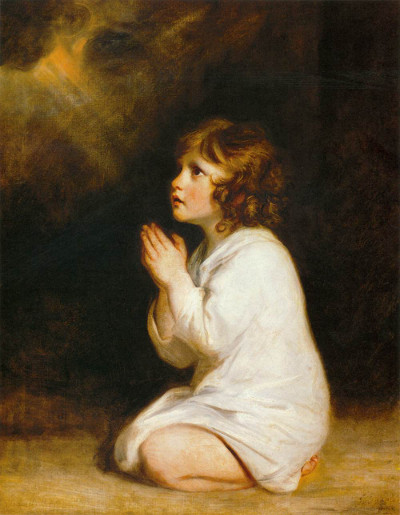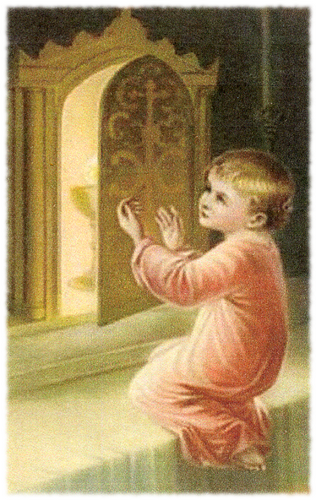Mental Prayer

Mental prayer is the means of entering into contact with God and letting ourselves be enkindled by the FIRE of His love.
It is the most fascinating and the most important art there is because it enables the human being to communicate with His Creator and to live the life of a child of God.
Engaging in mental prayer
Engaging in mental prayer is striving to draw closer to God through reflection and the upsurge of our heart; it is being lowly and humble in order to receive the Infinite who is giving himself to us. With practice and God’s help, it really becomes an exchange of ineffable love between two beings.
The purpose of mental prayer
The purpose of mental prayer is to make us always more like our divine examples (Mary, Jesus and Marie-Paule) by living by the Ten Commandments, better and better, so that our life becomes a hymn of praise in their wake.
The effects of mental prayer
- Mental prayer practised well can have an impact on our physical body (see The human being), because it can give the body the necessary strength to accomplish the desires God places in our hearts. It can also mark this latter with a certain mysterious radiance which comes from contact with the divine.
- Mental prayer practised well also has an impact on our psychic body because it helps us master well and make good use of our emotions, our desires and our affections so as to do what God expects of us. This leads us to inner peace.
- Finally, mental prayer done well has an impact on our spiritual body because it enkindles it so that it is more alert to doing good and avoiding evil; more alert also to believe, hope and love, drawing its strength from the infinity of God.
Thus, mental prayer practised well enkindles all our being with the Spirit’s FIRE of love. Consequently, we can evaluate its quality and its effectiveness according to the effects we can see in our everyday life, in our growing desire to place ourselves in God’s service.
Recollection during work
It is very useful to address ourselves to our dear Mother throughout the day and to talk to her simply, as a child would to its mother. Ask her how she would act in our place, ask for her help… Think of all it cost her to always do God’s will, which encourages us to accomplish the duties of our state well in spite of the difficulties which may arise. During our activities, let’s often multiply the upsurges of our hearts towards God.
“My God, I love you!”
“My God, I thank you for everything; I give you thanks!”
This helps keep our soul recollected and in a state of prayer throughout the day. Let’s like spending time working in the company of the divine Persons.
Accomplishing well the duties of our state contributes to bringing us closer to God because He hides within even the smallest little things we do out of love for Him. Every second spent doing our duty well, offering everything up for the salvation of souls, is like so many logs we throw onto the fire of our love.

Recollection during periods of silence
given over to mental prayer
It is preferable to begin our periods of silent mental prayer with an act of humility, asking our divine Mother to guide us in this activity which is beyond us (see The Consecration). Then, we can close our eyes in order to help us recollect ourselves. Imagine that God is very close to us – or “in us” – and that He can see us, hear us and love us.
Then, concentrate all our attention on seeking Him who is present in the innermost depths of our hearts, beyond our thoughts, feelings, emotions and desires, or the way we judge ourselves or others, and so forth. We must clearly understand that we are not looking for God somewhere in our physical body, as though we were trying to feel our physical heartbeat for example. No, we are looking for Him as though beyond everything that comes from the two brown and blue rings in the diagram of the internal influences:

Seeking union with Christ
During the periods of silence in mental prayer, it is important, above all, to seek union with Christ. We can think about His life in order to imitate Him and be united with Him through what He experienced while He was living on earth, being united with Him more particularly during His Passion.
Jesus encourages us to do so: "If anyone thirsts, let him come to me; let him drink." (Jn 7:37)
When our mental prayer seems to be arid or dry, let’s remember especially the moment when Christ was on the cross, when He no longer felt any consolation in spite of the fact that He was the beloved Son of God. His Father seemed to have completely abandoned Him... We too are beloved children of the Father, and it is by thinking about Christ that we can understand all the significance and greatness of this.
Those ideas can be applied just as much to our striving to be united with our dear Mother Co-Redemptrix, the beloved Daughter of God.
The position of the body
Is there one body position that would be better than others when engaged in mental prayer? Here, much freedom is necessary, the freedom of the children of God. However, the soul must always be on its knees, as a sign of humility, respect, adoration and love of God. Each one must find the position which helps him recollect himself and benefit well from the periods of mental prayer. This can also vary from one time to the next. In the first few minutes, a kneeling position could be useful in order to physically reflect our inner attitude. After that, follow your inspiration. On the other hand, our body can also be useful in mental prayer, as for example:
“Praying with our guardian angel”
“Praying the rosary with our arms out in a cross”
The time of mental prayer
Mental prayer can be practised at any time simply by taking a few minutes to recollect ourselves and uplift the eyes of our soul to God in an exchange of love. However, in the following pages, we are referring mainly to the silent mental prayer which we try to practise for a rather prolonged period of silence and, when possible, before the Blessed Sacrament.

References:
- Spiritual Letter Box on prayer by Marie-Paule Giguère: Click here.
- I Want to See God by Father Marie Eugène de l'Enfant-Jésus, pp. 234-248.
→
